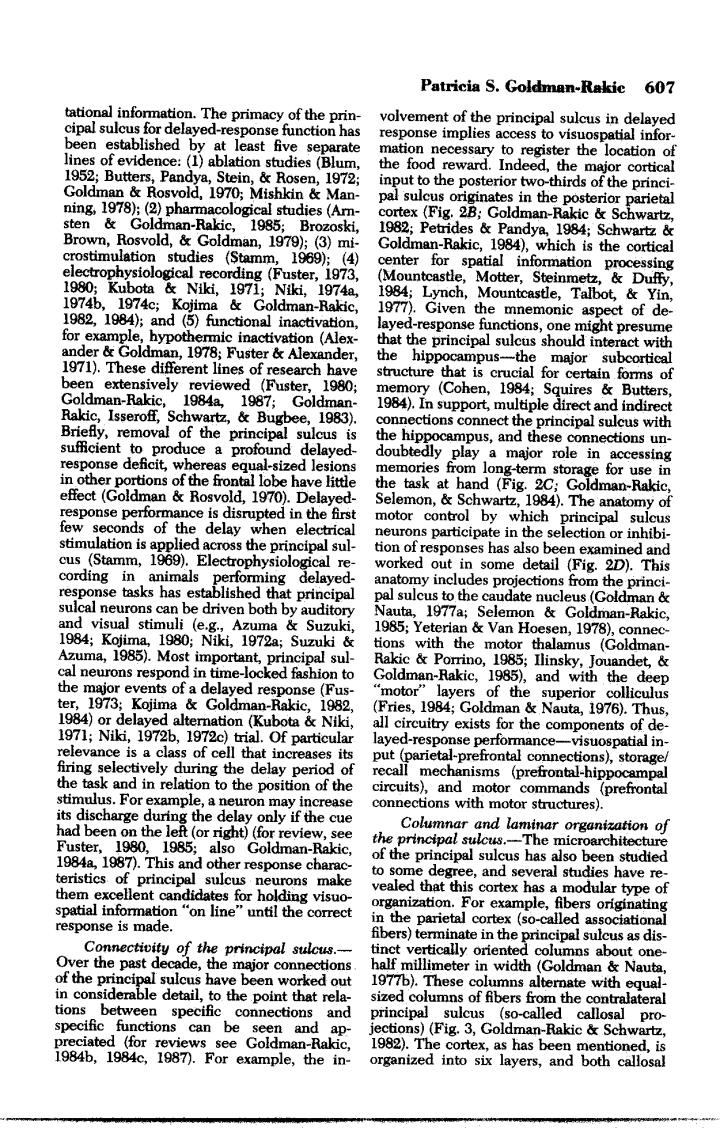正在加载图片...

Patricia S.Goldman-Rakic 607 nation The primacy of the al nyed of evidence: on necessary ster the location of input to the ical stud (Am 00贤 arietal rozoski Pe ides Par 1984 studies 3 hich is the corticai 1980 Lynch. onal respons one the principal sulcus should act rent l ines of e tructure that 1984a 1987 (Co ctions the duce a dou ections un d le from 1970 ed hand the motor control 63 stin h5o0s cross es h tion o inhi out some Fig. ven both 1977a K5 important,prir ndet, t ed re and 84 Go ,1972b,1972c uitry exists components s of c onnections).sto circuits) and (pre examp increase connecti (or right) Columnar and laminar org 0 bee The archite die an of principe sulcus make 0阳 modular type o until the response is made. e cortex cus as dis major comnec eredetail.to the point th ete in width sulc sized col s of n be nections and principa pro The as has beer example, the in organize into six layers,andtationa] information. The primacy of the principal sulcus for delayed-response function has been established by at least five separate lines of evidence; (1) ablation studies (Blum, 1952; Butters, Pandya, Stein, & Rosen, 1972; Goldman & Rosvold, 1970; Mishkin & Manning, 1978); (2) pharmacolo^cal studies (Amsten & Goldman-Rakic, 1985; Brozoski, Brown, Rosvold, & Goldman, 1979); (3) microstimulation studies (Stamm, 1969); (4) electrc^hysiological recording (Fuster, 1973, 1980; Kubota & Niki, 1971; Niki, 1974a, 1974b, 1974c; Kojima & Goldman-Rakic, 1982, 1984); and (5) functional inactivation, for example, hypodiermic iractivation (Alexander & Goldman, 1978; Fuster & Alexander, 1971). These different lines of research have been extensively reviewed (Fuster, 1980; Goldman-Rakic, 1984a, 1987; GoldmanRakic, Isseroff, Schwartz, & Bugbee, 1983). Briefly, remold of the princi{»l sulcus is sufficient to produce a profound delayedresponse deficit, whereas equal-sized lesions in other portions of the front^ lolw have little effect (Goldman & Rosvold, 1970). Delayedresponse performance is disrupted in die first few seconds of the delay when electrical stimulation is applied across the principal sulcus (Stamm, 1969). Electrc^hysiological recording in animals performing delayedresponse tasks has established that principal sulcal neurons can be driven both by auditory and visual stimuli (e.g., Azuma & Suzuki, 1984; Kojima, 1980; Niki, 1972a; Suzuki & Azuma, 1985). Most important, principal sulcal neurons respond in time-locked foshion to the xnaior events of a delayed response (Fuster, 1973; Kojima & Goldman-Rakic, 1982, 1984) or delayed alternation (Kubota & Niki, 1971; Niki, 1972b, 1972c) trial. Of particular relevance is a class of cell that increases its firing selectively during the delay period of the task and in relation to die position of the stimulus. For example, a neuron may increase its dischfuge during the delay only if die cue had been on the left (or ri^t) (for review, see Fuster, 1980, 1985; also Golcbnan-Rakic, 1984a, 1987). This and other response characteristics of principal sulcus neurons make them excellent candids^s for holding visuospatial information "on line" until die correct response is made. Connectivity of the principal sulcus.— Over the past decade, die rasgor connections of the principal sulcus have been worfted out in considerable detail, to the point that relations between specific connections and specific functions can be seen and appreciated (for reviews see Goldman-R^c, 1984b, 1984c, 1987). For example, die inPatricia S. Goldman-Rakic 607 volvement of the principal sulcus in delayed response implies access to visuospatial information necessary to register the location of the food reward. Indeed, the major cortical input to the posterior two-thirds of die principal sulcus originates in the posterior parietal cortex (Fig. 2B; Goldman-Rakic & Schwartz, 1^2; Petrides & Pandya, 1984; Schwartz & Goldman-Rakic, 1984), which is the cortical center for spatial information processing (Mountcastle, Motter, Steinmetz, & Dufiy, 1984; Lynch, Mountcastle, Tdbot, & Yin, 1977). Given the mnemonic aspect of delayed-response functions, one mi^ t presume that the principal sulcus shotild interact with die hippocampus—the m^or subcortical structure that is crucial for certain forms of memory (Gohen, 1984; Squires & Butters, 1984). In support, multiple direct and indirect connections connect the principal sulcus with the hippocampus, and these connections undoubtedly play a m£^or role in assessing memories from long-term storage for use in the task at hand (Fig. 2C; Goldman-iUkic, Selemon, & Schwartz, 1984). The anatomy of motor control by which principal sulcus neurons participate in the selection or inhibition of responses has also been examined and worked out in some detail (Fig. 2D). This anatomy includes projections from the jaincipal sulcus to the caudate nucleus (Goidman & Nauta, 1977a; Selemon & Goldman-Rakic, 1985; Yeterian & Van Hoesen, 1978), connections with the motor thalamus (GoldmanRakic & Porrino, 1985; Ilinsky, Jouandet, & Goldman-Rakic, 1985), and with the deep "motor" layers of the superior colliculus (Fries, 1984; Goldman & Nauta, 1976). Thus, all circuitry exists for the components of delayed-response performance—visuospatial input (pariet^-prefrontal connections), storage/ recall mechanisms (prefrontal-hippocMnpal circuits), and motor commands (preftontal connections with motor structures). Columnar and laminar organisation of the prifuHpal sulcus.—The microarchitecture of the principal sulcus has also been studied to some degree, and several studies have revealed that diis cortex has a modular type of organization. For example, fibers originating in the parietal cortex (so-celled associational fibers) terminate in the principal sulcus as distinct vertically oriented columns about onehalf millimeter in width (Goldman & Nauta, 1977b). These columns altemate with equalsized colunms of fibers from the contralateral principal sulcus (so-called callosal projections) (Fig. 3, Goldman-Rakic & Schwartz, 1982). The cortex, as has been mentioned, is organized into six layers, and both callosal